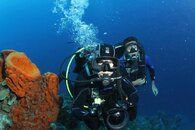EL Pistoffo
Contributor
I'm horrible with determining what "correct" color is. That's why these cards help me so much. I do have to adjusted brightness and contrast on my own but that's easier for me.There are limitations with color correcting video. Video raw is not the same as photo raw and color correcting video requires much more computer power than correcting photo. I have a pretty powerful computer. I like to shoot protune cam raw with a filter. A little boost to contrast and minor color correction in editing gives me better and more consistent color. However, I am a little critical when it comes to color and luckily have a capable computer.
True that more processing power is required than photo. Essentially what I'm doing in this case is doing a color correction with the cards under a certain lighting condition and then saving and applying that filter setting to all the clips which are under the same conditions. If conditions change, such as greater or lesser depth or sudden change to overcast skies or water clarity, then I have to re-introduce the cards and re-correct color in post and apply to all the video shot under those new conditions. It's basically creating a filter mask and applying it to your clips. No massive processing required.
I have a Six core processor and 16GB of RAM so that probably helps.





